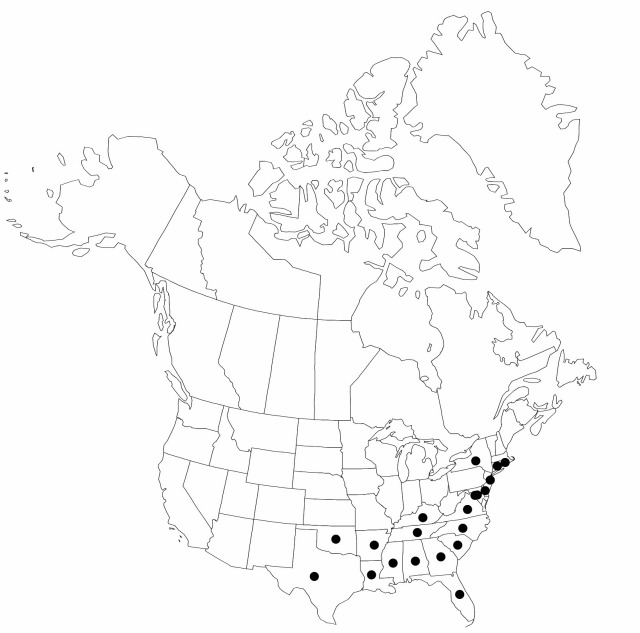Difference between revisions of "Fuirena squarrosa"
Fl. Bor.-Amer. 1: 37. 1803.
FNA>Volume Importer |
FNA>Volume Importer |
||
| Line 26: | Line 26: | ||
|elevation=0–500 m | |elevation=0–500 m | ||
|distribution=Ala.;Ark.;Conn.;Del.;D.C.;Fla.;Ga.;Ky.;La.;Md.;Miss.;N.J.;N.Y.;N.C.;Okla.;R.I.;S.C.;Tenn.;Tex.;Va. | |distribution=Ala.;Ark.;Conn.;Del.;D.C.;Fla.;Ga.;Ky.;La.;Md.;Miss.;N.J.;N.Y.;N.C.;Okla.;R.I.;S.C.;Tenn.;Tex.;Va. | ||
| − | |discussion=<p>Fuirena squarrosa is most similar to F. pumila in perianth except it is perennial; to F. breviseta except its distal sheaths are hirsute, not glabrous; and to F. bushii except its perianth blade is flatter and the anthers shorter.</p><!-- | + | |discussion=<p><i>Fuirena squarrosa</i> is most similar to <i>F. pumila</i> in perianth except it is perennial; to <i>F. breviseta</i> except its distal sheaths are hirsute, not glabrous; and to <i>F. bushii</i> except its perianth blade is flatter and the anthers shorter.</p><!-- |
--><p>Plants of the Gulf and Atlantic coastal plains and inland to adjacent provinces east of the Mississippi River usually have closely set cormose rhizome buds.</p> | --><p>Plants of the Gulf and Atlantic coastal plains and inland to adjacent provinces east of the Mississippi River usually have closely set cormose rhizome buds.</p> | ||
|tables= | |tables= | ||
| Line 51: | Line 51: | ||
|publication year=1803 | |publication year=1803 | ||
|special status= | |special status= | ||
| − | |source xml=https://jpend@bitbucket.org/aafc-mbb/fna-data-curation.git/src/ | + | |source xml=https://jpend@bitbucket.org/aafc-mbb/fna-data-curation.git/src/8f726806613d60c220dc4493de13607dd3150896/coarse_grained_fna_xml/V23/V23_48.xml |
|genus=Fuirena | |genus=Fuirena | ||
|species=Fuirena squarrosa | |species=Fuirena squarrosa | ||
Revision as of 16:08, 18 September 2019
Herbs perennial, cespitose, to 1 m; rhizomes scaly; offshoots cormose. Culms erect to leaning, smooth except in inflorescence. Leaves: all sheaths hispid-hirsute, sometimes also hirtellous; principal blades linear, 8–20 cm, abaxially puberulent, hispid-hirsute, adaxially hispid-hirsute-ciliate, scabridulous. Inflorescences in clusters of terminal spikelets or from 1–3 penultimate nodes, proximalmost involucral bract longest, exceeding inflorescence, distal 1–2 bracts shorter. Spikelets ovoid to cylindric-lanceoloid, 1–2 cm, apex acute; fertile scales 2.5–3.5 mm; cusp excurved, more than 1/2 length of scale, scabrid; ribs 3–5(–7). Flowers: perianth bristles reaching base of perianth blades or beyond, retrorsely barbellate; perianth blades narrowly to broadly ovate, uniformly compressed or distally tumid, 1 mm, base 3-ribbed, apex incurved, acuminate; anthers 3, 1 mm. Achenes: stipe shorter than perianth stipe; body angles wirelike, pale, faces deep brown to chestnut brown, faintly cross-lined, 1 mm. 2n = 46.
Phenology: Fruiting summer–fall.
Habitat: Wet acid substrates, bogs, seeps, ditches, pond and lakeshores, savanna, and flatwoods
Elevation: 0–500 m
Distribution

Ala., Ark., Conn., Del., D.C., Fla., Ga., Ky., La., Md., Miss., N.J., N.Y., N.C., Okla., R.I., S.C., Tenn., Tex., Va.
Discussion
Fuirena squarrosa is most similar to F. pumila in perianth except it is perennial; to F. breviseta except its distal sheaths are hirsute, not glabrous; and to F. bushii except its perianth blade is flatter and the anthers shorter.
Plants of the Gulf and Atlantic coastal plains and inland to adjacent provinces east of the Mississippi River usually have closely set cormose rhizome buds.
Selected References
None.
